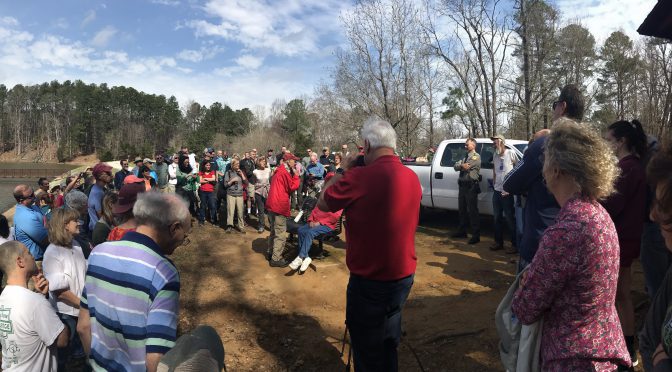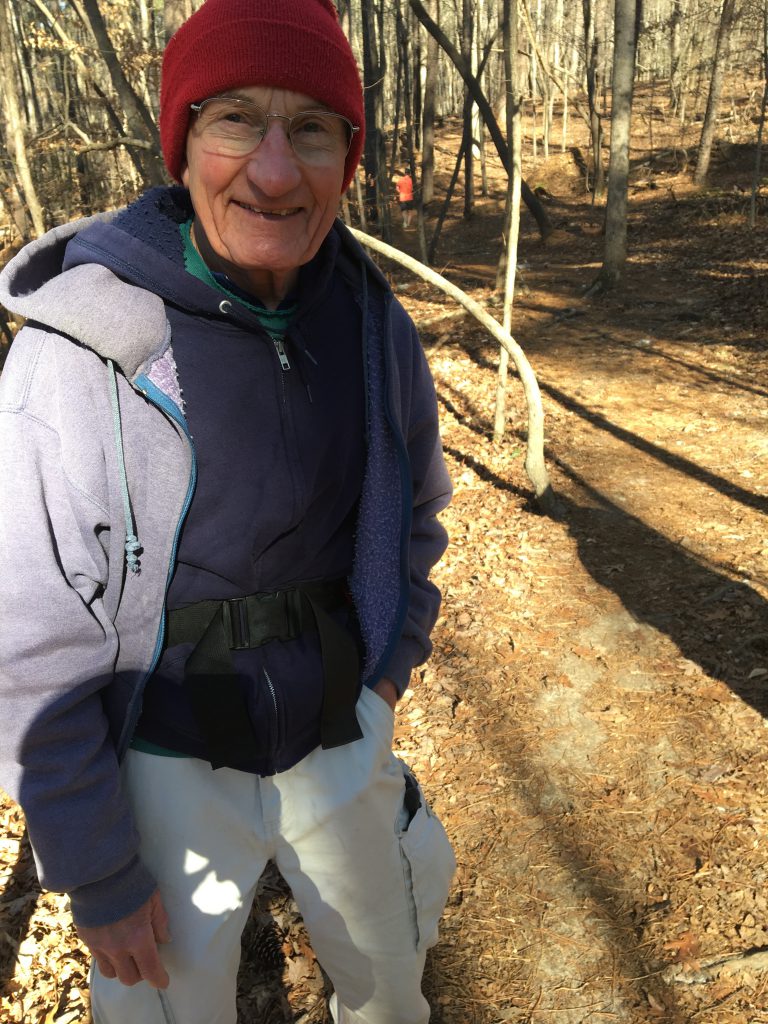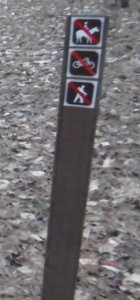There was a bit of concern at the end of Saturday’s hike. “I’ve only got 19.8 miles on my pedometer,” said Bob. That sparked discussion among the first half dozen or so of us to finish our six-and-a-half-hour trek. “I hope that’s not what Rod’s pedometer says,” groaned one fellow who appeared to have just enough energy left to walk the 20 yards to his car. Asked a woman on the ground stretching,“Do you think he’d make us go back out?”
“He” was Rod Broadbelt. For 13 years, Rod has been leading a monthly hike at Umstead State Park (though he usually takes November off and goes to Raven Rock State Park). In the summer, bowing to the heat, Rod keeps the hikes short, sometimes as short as 10 miles. In cooler weather, he ups the ante. He’s gone as far as 24, and next month he’ll also only do 10 miles, albeit most of that “wilderness” hike is bushwhacking off trail. Today’s hike — from the Company Mill trailhead on the south side of 5,579-acre Umstead to the Visitors Center on the north side and back — was advertised at 20, and Rod’s not one to cut corners. If he says you’re going to go 20 miles and you want to go 20 miles, he’s not about to short you with 19.8.
When Rod retired in the 1990s, he and wife Dorothy moved from the Philadelphia area to Cary to be closer to their daughter and her family. He left behind his beloved Chester County Trail Club, a group of several hundred that took its hiking seriously. They took short hikes. But they also took very long ones. When Rod couldn’t find anything similar in the Triangle he approached the Umstead Coalition about leading hikes under their banner. Those hikes soon became legendary for their distance and blistering pace. Rod is not a stop-and-smell-the-flowers guy. Stop — slow down even — and you’ll be left in the dust (although he will dispatch a search party if a hiker goes missing). At the start of Saturday’s lunch break, one woman, worried that the group would depart post-haste, told Rod she had to run to the bathroom, but she’d hurry.
“Take your time,” Rod said, “We’ll be here for a while.” Conversation stopped as the faithful listened to see if Rod would elaborate on his notion of a while. “We’ll be here 15 minutes.”
On his first “ruins” hike — a tour of Umstead’s human past that was supposed to be as enlightening as it was aerobic — Rod didn’t break stride as he pointed out park history: “That’s an old homestead,” he said pointing left. To the right, “That’s an old cemetery.
Though he pushes a healthy pace (the first four miles of Saturday’s hike were ticked off in just under an hour), Rod’s hikes easily pass the talk-and-walk test. Twenty-seven people headed out on the trail Saturday and it’s a good bet that each person talked with at least half the people on the hike.
I chatted with Shirley, who just turned 65 and has only been hiking two years. Yet she already has explored the Slickrock Wilderness and Panthertown Valley in western North Carolina, climbed peaks in Washington and spent a couple weeks exploring in New Zealand. I chatted with Jane, a Canadian expat who does an 11-mile hike once a week with some women from her gym. I talked to Mike, who’s part of a volunteer crew refurbishing dilapidated cabins in the park.
And I marveled at Rod. Despite being an avid hiker, hiking boots are his only concession to modern hiking gear. His white cargo pants appear to be cotton, and as the weather warmed — it was 28 degrees at the 8 a.m. start before rising into the upper 40s — he peeled back two cotton hoodies and a flannel shirt, keeping them tied around his waste. (He’s old school, too, in that one of the hikers had to gently remind him to drink water.) At one point, when there was confusion about a couple hikers’ names, someone jokingly suggested name tags. “I don’t want any bureaucracy,” Rod quickly responded. About the only tolerance Rod has for that kind of thing is the monthly e-mail he sends reminding folks of upcoming hikes. Hiking club newsletter? Web site? Club name? Not in Rod’s hiking army.
And I marveled that Rod hasn’t lost a step since he started leading these hikes 13 years ago. “I want to lead this hike when I’m 80!” Rod said on Saturday. He’s 77.
As Rod and a handful of hikers made their way out of the woods around 3 p.m. and approached the trailhead, the suspense mounted. “Well?” someone from the first wave to finish asked, “What’s your pedometer say?”
Rod shrugged: “Equipment malfunction. The thing kept falling off my pants.”
Had we the strength, we would have issued a collective sigh of relief.
* * *
Hike with Rod?
Here’s a look at Rod Broadbelt’s upcoming hikes at Umstead:
March 12, annual Wilderness Hike, approximately 10 miles.
April 9, Carter-Finley Stadium hike, 13.5 miles.
May 7, Umstead to Lake Crabtree and back, 13.5-14 miles.
read more


